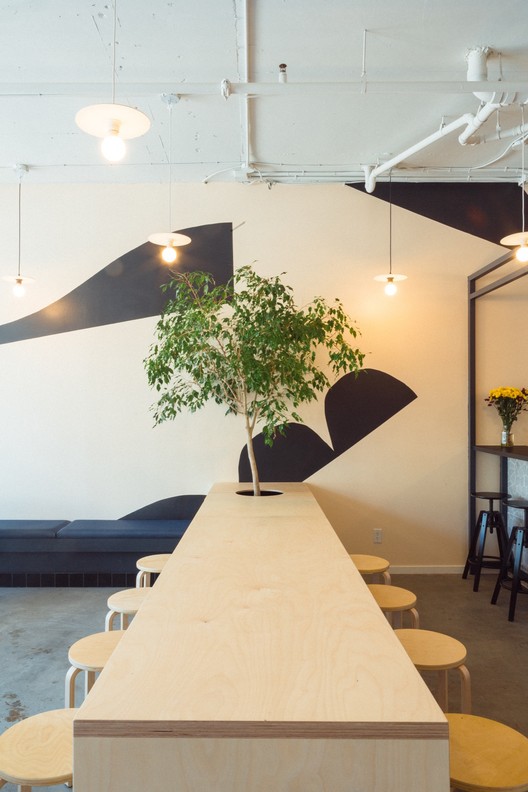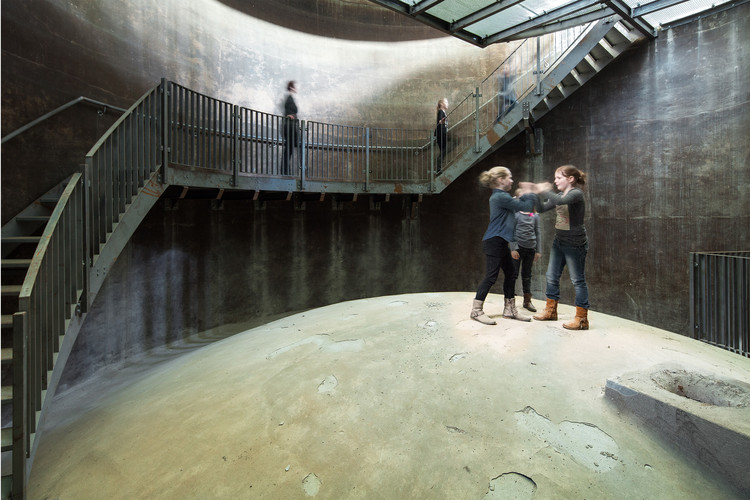Linxia Olympic Sports Center Stadium DUTS design
2018-11-23 02:00
架构师提供的文本描述。位于临夏规划新城核心区的临夏奥林匹克体育中心体育场占地面积41,134平方米,总建筑面积28,452平方米。这座建筑由礼堂和国际标准体育场组成。它是一家以大中型体育竞赛和训练为主要功能的大型体育设施,综合考虑了市民的休闲、健身、娱乐等功能,可容纳20,410人。该项目已经完成,并已成为临夏具有里程碑意义的文化设施之一。
Text description provided by the architects. Located in the core area of Linxia Planned New Town, Linxia Olympic Sports Center Stadium covers an area of 41,134 square meters with a total construction area of 28,452 square meters. The building is composed of auditorium and international standard stadium. It is a large-scale sports facility with large and medium-sized sports competitions and training as its main function, taking into account the functions of leisure, fitness and entertainment of the citizens, with a total seating capacity of 20,410. The project has been completed and has become one of the landmark cultural facilities in Linxia.
Text description provided by the architects. Located in the core area of Linxia Planned New Town, Linxia Olympic Sports Center Stadium covers an area of 41,134 square meters with a total construction area of 28,452 square meters. The building is composed of auditorium and international standard stadium. It is a large-scale sports facility with large and medium-sized sports competitions and training as its main function, taking into account the functions of leisure, fitness and entertainment of the citizens, with a total seating capacity of 20,410. The project has been completed and has become one of the landmark cultural facilities in Linxia.
从临夏鹤州的牡丹、彩陶、色彩装饰等特点,产生了建筑灵感。设计以牡丹花为意象主题,采用外花瓣为薄壳空间的牡丹花瓣结构体系,可表示为合理的大跨度结构,造型美观。其造型灵感来源于彩陶的弧形,力求与内部功能布局紧密结合。我们设计了一个合理的大跨度结构和适用空间的统一体,以体现结构和逻辑的美,从而实现大空间的经济性和舒适性。
It is architectural inspiration that derives from Linxia Hezhou's characteristics such as peony, painted pottery and color decoration. The design uses the peony flower as the image theme and adopts the peony petal structure system whose outer petal is a thin shell space, which can be expressed as a reasonable long-span structure, and the shape is fairly beautiful. The shape is inspired by the arc of painted pottery, striving to integrate closely with the internal functional layout. We have designed a unified body with reasonable long-span structure and applicable space in order to embody the beauty of structure and logic so that the economy and comfort of large space can be realized.
It is architectural inspiration that derives from Linxia Hezhou's characteristics such as peony, painted pottery and color decoration. The design uses the peony flower as the image theme and adopts the peony petal structure system whose outer petal is a thin shell space, which can be expressed as a reasonable long-span structure, and the shape is fairly beautiful. The shape is inspired by the arc of painted pottery, striving to integrate closely with the internal functional layout. We have designed a unified body with reasonable long-span structure and applicable space in order to embody the beauty of structure and logic so that the economy and comfort of large space can be realized.
根据建筑图像,体育场顶棚的最大悬挑高度可达48米,采用钢桁架结构设计,其中三角形钢管桁架处于位置。主桁架由圆弧桁架连接,模拟建筑图像中的花瓣。为了保证视觉的美观,主桁架采用均匀的横截面,完全符合建筑的弧形,使观众既能欣赏到精彩的活动,又能欣赏到大跨度钢结构的异乎寻常的魅力。
According to the architectural image, the maximum cantilever of stadium canopy is up to 48 meters and utilizes the design of steel truss structure, where triangular steel pipe truss is positioned. The main truss is connected by the circular arc truss to simulate the "petals" in the architectural image. In order to ensure visual beauty, the main truss adopts uniform cross-section and fully fits the arc of the building so that the spectators can enjoy the wonderful events and appreciate the unusual charm of the long-span steel structure at the same time.
According to the architectural image, the maximum cantilever of stadium canopy is up to 48 meters and utilizes the design of steel truss structure, where triangular steel pipe truss is positioned. The main truss is connected by the circular arc truss to simulate the "petals" in the architectural image. In order to ensure visual beauty, the main truss adopts uniform cross-section and fully fits the arc of the building so that the spectators can enjoy the wonderful events and appreciate the unusual charm of the long-span steel structure at the same time.
在功能布局上,主入口广场设置在体育场东侧,集中绿地布置在东北侧和东南侧,并与室外运动场和停车场相结合。体育场有四个入口处,正门在基地东侧的柴庄路。有两个游客入口,分为行人入口和车辆入口。西广场的主要入口是具有一定分布容量的行人入口。东门的设计主要是根据车辆的交通情况进行的。在奥林匹克体育中心规划道路的南侧,有贵宾、运动员和媒体记者的出入口。如有必要,也可用作观众的紧急疏散点。基地东侧的浙黄路和北侧的龙岩南路的开通,主要作为各类人员的紧急疏散出口。
When it comes to the layout of function, the main entrance plaza is set on the east side of the stadium, and the concentrated green space is arranged at the northeast and southeast side combined with the outdoor sports ground and parking space. The stadium has four entrances, and the main entrance is on the Zheshuang Road on the east side of the base. There are two visitors' entrances, which are divided into pedestrian entrance and vehicle entrance. The main entrance of westward plaza is a pedestrian entrance with a certain distribution capacity. The design of the east entrance is mainly based on the vehicle traffic. On the south side of the planning road of the Olympic Sports Center, there are entrances and exits for VIPs, athletes and media reporters. If necessary, they can also be used as emergency evacuation points for spectators. The opening of Zheshuang Road on the east side and Longyan South Road on the north side of the base are mainly used as emergency evacuation exits for various personnel.
When it comes to the layout of function, the main entrance plaza is set on the east side of the stadium, and the concentrated green space is arranged at the northeast and southeast side combined with the outdoor sports ground and parking space. The stadium has four entrances, and the main entrance is on the Zheshuang Road on the east side of the base. There are two visitors' entrances, which are divided into pedestrian entrance and vehicle entrance. The main entrance of westward plaza is a pedestrian entrance with a certain distribution capacity. The design of the east entrance is mainly based on the vehicle traffic. On the south side of the planning road of the Olympic Sports Center, there are entrances and exits for VIPs, athletes and media reporters. If necessary, they can also be used as emergency evacuation points for spectators. The opening of Zheshuang Road on the east side and Longyan South Road on the north side of the base are mainly used as emergency evacuation exits for various personnel.
体育场观众席的外部轮廓为椭圆平面,使东西向站具有较好的视觉距离质量,可以容纳更多观众,最大限度地增加视觉质量区域内的观众数量。西看台一楼由运动员、裁判员、组委会、记者和新闻中心组成。西站二楼主要是观众的休息平台。展位下面的空间设计有厕所、服务室、设备和其他设施。东看台一楼设有办公空间和商品房,供对外开发。讲坛位于西边看台的中央,试图用收回和提升的方式,从一般的礼堂中分离出来,形成一种良好的深度感。
The exterior contour of stadium auditorium is elliptical plane so that the east and west stands with better visual distance quality can accommodate more spectators and maximize the number of spectators in the visual quality area. The ground floor of west stand is composed of rooms for athletes and referees, organizing committee, journalists and news centers. The second floor of west stand is mainly a rest platform for the audience. The space under the stand is designed with toilets, service rooms, equipment and other facilities. The ground floor of east stand is equipped with office space and commercial housing for external development. The rostrum is located in the central part of west stand, attempting to form a good sense of depth by disengaging from the general auditorium with the means of retracting and raising.
The exterior contour of stadium auditorium is elliptical plane so that the east and west stands with better visual distance quality can accommodate more spectators and maximize the number of spectators in the visual quality area. The ground floor of west stand is composed of rooms for athletes and referees, organizing committee, journalists and news centers. The second floor of west stand is mainly a rest platform for the audience. The space under the stand is designed with toilets, service rooms, equipment and other facilities. The ground floor of east stand is equipped with office space and commercial housing for external development. The rostrum is located in the central part of west stand, attempting to form a good sense of depth by disengaging from the general auditorium with the means of retracting and raising.
Location Linxia, Gansu, China
Chief Architect Ling Zhong
Architectural Design Team Ahn Yunsil, Ellix WU, Sun Jinyin
Structural Design Team Xiang Fang, Maoming Zhang
 举报
举报
别默默的看了,快登录帮我评论一下吧!:)
注册
登录
更多评论
相关文章
-

描边风设计中,最容易犯的8种问题分析
2018年走过了四分之一,LOGO设计趋势也清晰了LOGO设计
-

描边风设计中,最容易犯的8种问题分析
2018年走过了四分之一,LOGO设计趋势也清晰了LOGO设计
-

描边风设计中,最容易犯的8种问题分析
2018年走过了四分之一,LOGO设计趋势也清晰了LOGO设计








































































































